Half Head Migraine: Signs, Causes & Relief Options
Half Head Migraine: Signs, Causes & Relief Options
Migraines can be very hard to deal with, especially when they only hit one side of the head. Half head migraines, or hemicranial migraines, are a type that affects one side of the brain. They cause intense pain, sensitivity, and other symptoms. It’s important to know the signs, causes, and ways to find relief for this condition.
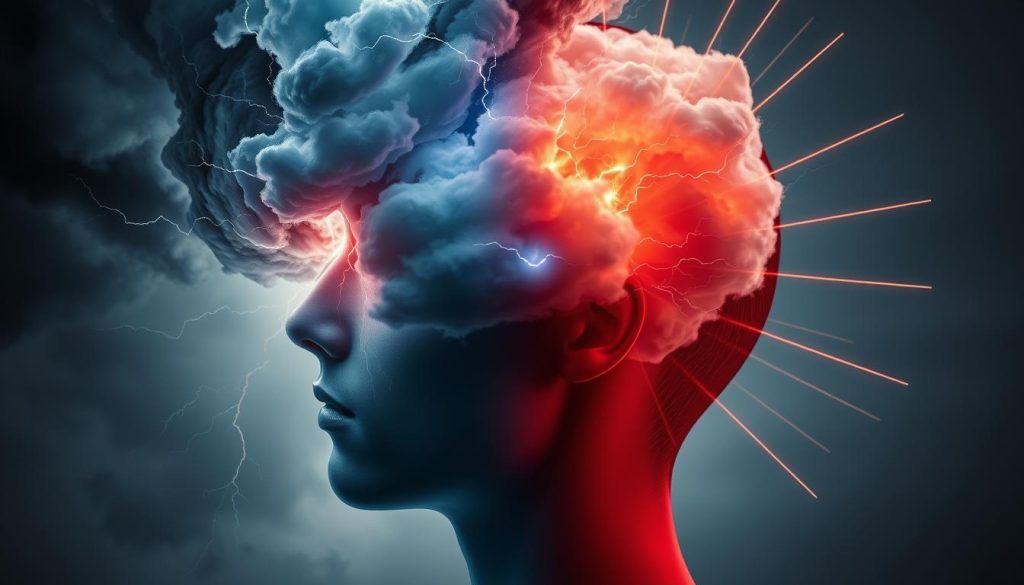
Key Takeaways
- Half head migraines are a specific type of migraine that affects only one side of the head.
- Common symptoms include severe, throbbing pain, sensitivity to light and sound, and nausea or vomiting.
- Potential triggers include stress, hormonal changes, certain foods, and environmental factors.
- Immediate relief strategies like cold therapy, over-the-counter medications, and relaxation techniques can provide temporary relief.
- Long-term prevention may involve prescription medications, lifestyle changes, and alternative therapies.
Understanding Half Head Migraine: An Overview
Migraines are a complex condition that can show up in different ways. Half head migraine is a severe form that affects one side of the head. It’s also known as unilateral or hemi-migraine.
Differentiating Half Head Migraines from Other Headaches
Half head migraines are different from other headaches like cluster headaches and tension headaches. Cluster headaches cause severe pain around the eye or temple. But half head migraines spread pain across one side of the head.
Tension headaches are dull and spread across the whole head. Half head migraines, however, are intense and pulsating, focused on one side.
Key Characteristics of Half Head Migraines
Half head migraines have some key features. These include:
- Unilateral pain: The pain is on one side of the head, often in the forehead, temple, and/or cheek.
- Pulsating or throbbing sensation: The pain feels like a pulsating, pounding, or throbbing sensation.
- Sensitivity to light and sound: Patients are more sensitive to light and sound during a migraine episode.
- Nausea and vomiting: Many people with half head migraines also feel nauseous and may vomit.
Knowing these unique features is important for diagnosing and managing half head migraines.
Common Symptoms and Warning Signs
Having a half head migraine can really disrupt your day. These migraines have specific symptoms that make them stand out. Knowing what to look for can help you manage them better.
A half head migraine often causes pain on one side of the head. This pain can feel like it’s pulsating. You might also see things like flashing lights or blind spots. Feeling sick to your stomach, vomiting, and being really sensitive to light and sound are common too.
Before a migraine hits, you might feel some early signs. These can include feeling really tired, yawning a lot, or getting easily upset. You might also find it hard to focus or notice things more easily.
- Changes in mood, such as irritability or depression
- Difficulty concentrating or focusing
- Yawning or fatigue
- Increased sensitivity to sensory stimuli
Spotting these early signs can help you take steps to prevent or lessen the migraine’s impact.
| Symptom | Description |
|---|---|
| Unilateral Headache | A throbbing or pulsating pain on one side of the head |
| Visual Disturbances | Aura, flashing lights, blind spots, or other visual anomalies |
| Nausea and Vomiting | Accompanying gastrointestinal symptoms |
| Sensitivity to Light and Sound | Increased sensitivity to sensory stimuli |
| Prodromal Symptoms | Early warning signs, such as changes in mood, difficulty concentrating, and fatigue |
By knowing the symptoms and warning signs of half head migraines, you can better handle them. This can improve your life and reduce how much they disrupt your day.
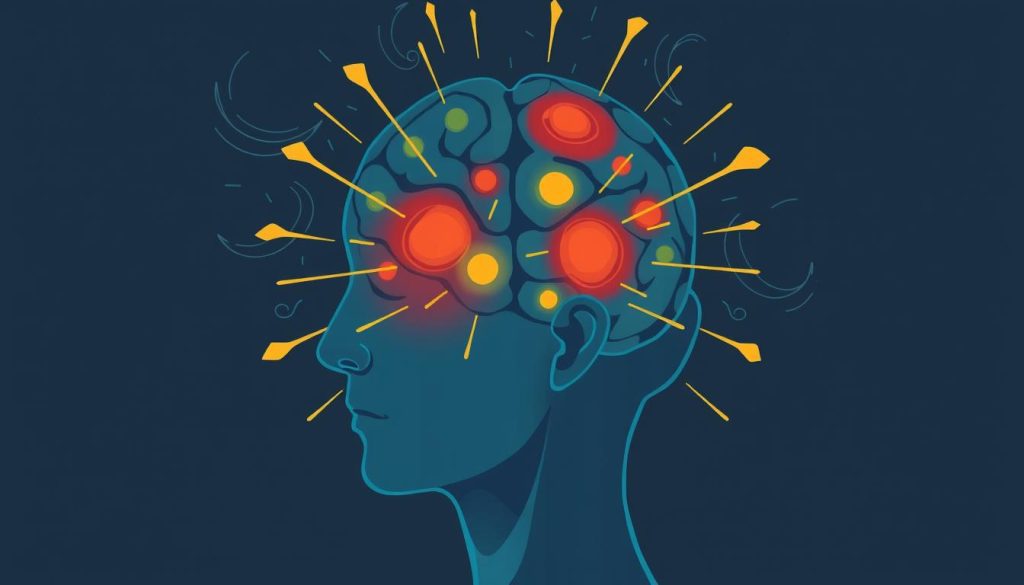
What Triggers Half Head Migraine Episodes
Knowing what triggers half head migraines is key to managing them. Migraines are complex, with many factors like environment, diet, lifestyle, and hormones playing a role. By finding out what triggers your migraines, you can take steps to prevent or lessen their impact.
Environmental Triggers
Things around us can trigger migraines. Bright lights, loud sounds, strong smells, and weather changes can upset our brains and cause headaches. Being aware of your environment and avoiding known triggers can help prevent migraines.
Dietary and Lifestyle Factors
Some foods and lifestyle choices can also trigger migraines. Foods like processed meats, aged cheeses, and alcohol, along with irregular sleep, can be triggers. Eating well and getting enough sleep can help lower your risk of getting a migraine.
Hormonal Influences
Hormonal changes can also play a big role in migraines, especially for women. Changes during menstruation, birth control, pregnancy, or menopause can trigger headaches. Keeping track of your cycle and managing hormonal changes with your doctor can help prevent migraines.
| Trigger Type | Examples |
|---|---|
| Environmental | Bright lights, loud noises, strong smells, weather changes |
| Dietary and Lifestyle | Processed meats, aged cheeses, alcohol, irregular sleep, skipping meals |
| Hormonal | Menstrual cycles, birth control, pregnancy, menopause |
By knowing and avoiding your personal triggers, you can manage migraines better. This can greatly improve your daily life.
“Identifying and avoiding personal migraine triggers is essential for managing this condition and improving quality of life.”
The Science Behind Half Head Migraine Pain
Migraines, especially those on one side of the head, are complex. They involve a fascinating science. The main causes of migraine causes and chronic migraine come from a mix of neurotransmitters, blood vessels, and brain nerve pathways.
The core of a half head migraine is the trigeminovascular system. This system includes nerves and blood vessels in the face and head. When it gets too sensitive, it can start releasing neurotransmitters like serotonin and CGRP. This makes blood vessels widen and the surrounding tissues get inflamed.
This chain of events causes the pulsing, throbbing pain often felt on one side of the head during a migraine. Why migraines only affect one side is still a mystery. But it’s thought to be linked to the brain’s nervous system being asymmetrical and how it handles pain signals.
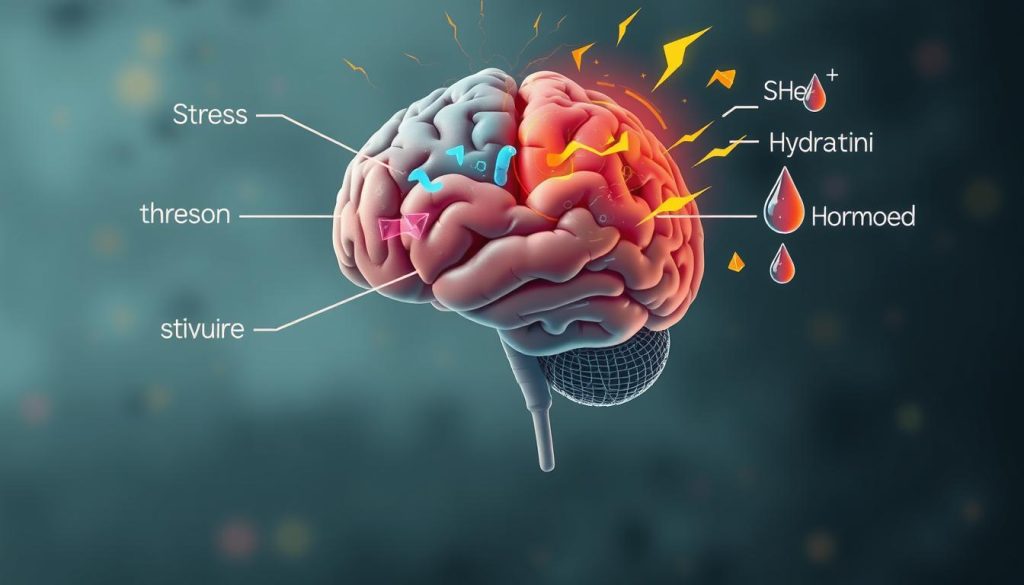
Researchers are still trying to understand migraine causes and chronic migraine. They aim to find better treatments and ways to prevent them. By grasping the science behind half head migraines, doctors can improve how they manage this tough condition.
Diagnosing Half Head Migraines: Medical Assessment
Getting a correct diagnosis for half head migraines is key to finding the right treatment. Doctors use a detailed process to find the cause and rule out other conditions.
Diagnostic Tests and Procedures
The first step is a detailed look at your medical history. This includes when, how long, and how bad your migraines are. Doctors also do physical checks to see if there’s muscle tension or other issues.
- Neuroimaging tests, like MRI or CT scans, check for structural problems or other conditions like tumors or blood vessel issues.
- Special tests, like a spinal tap or EEG, look at brain activity and cerebrospinal fluid.
- Blood tests check for hormonal imbalances, nutrient deficiencies, or inflammation that might cause migraine symptoms.
Working with Healthcare Providers
It’s important to work well with your healthcare team to diagnose and manage chronic migraine. Be ready to share your medical history, symptoms, and what might trigger them.
| Healthcare Provider | Role in Diagnosing Half Head Migraines |
|---|---|
| Primary Care Physician | Does the first check-up, orders tests, and makes a treatment plan |
| Neurologist | Focuses on headaches and might do more tests or refer you to others |
| Pain Management Specialist | Offers treatments and other ways to handle chronic migraine pain |
By teaming up with your healthcare team, you can get a full diagnosis. Then, you can work on a treatment plan that fits your specific needs.
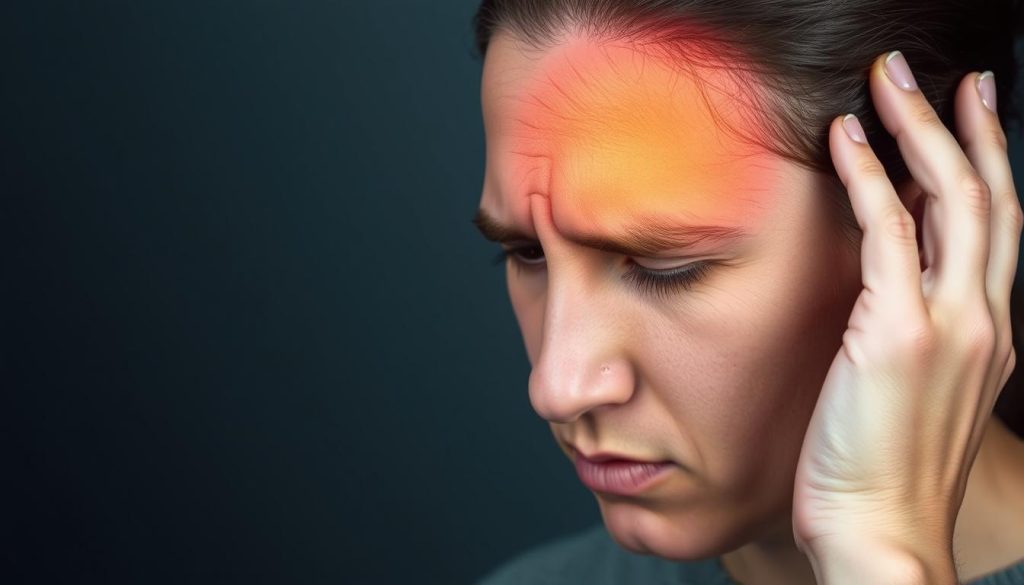
Immediate Relief Strategies and Home Remedies
When a half head migraine hits, quick relief is key. Luckily, there are many ways to ease the pain at home. Let’s look at some effective options.
Relaxation Techniques
Stress can make migraines worse. Relaxation techniques can help. Try deep breathing, meditation, or a simple neck and shoulder massage to relax.
Temperature Therapy
Hot or cold compresses can soothe your head. A cold pack can numb the pain, while a warm compress relaxes muscles. See what works best for you.
Over-the-Counter Pain Relievers
Medicines like ibuprofen, acetaminophen, or aspirin can help. Always follow the dosage and watch for side effects or interactions.
| Immediate Relief Strategy | Description | Effectiveness |
|---|---|---|
| Relaxation Techniques | Deep breathing, meditation, massage | Helps reduce stress and tension |
| Temperature Therapy | Cold or warm compresses | Can alleviate pain and inflammation |
| Over-the-Counter Pain Relievers | Ibuprofen, acetaminophen, aspirin | Provides migraine treatment for mild to moderate pain |
While home remedies can help, see a doctor if they don’t work. A healthcare provider can help find the cause and treat it.

Medical Treatment Options and Medications
Managing half head migraines involves using medical treatments and medications. These include preventive drugs, acute treatments, and alternative therapies. Each option helps manage chronic migraine symptoms.
Preventive Medications
Preventive drugs aim to lessen migraine frequency and severity. They include anti-seizure drugs, antidepressants, and blood pressure meds. These have proven effective in preventing attacks. Regular use can significantly reduce migraine days.
Acute Treatment Options
For quick relief, acute treatments are available. These include over-the-counter pain relievers, triptans, and anti-nausea meds. They can lessen migraine intensity and offer relief.
Alternative Therapies
Some people find relief in alternative therapies. These include acupuncture, chiropractic care, and essential oils or herbal remedies. While their effectiveness varies, they offer a complementary option.
Working with a healthcare provider is key to finding the right treatment for half head migraines. Exploring different treatments can help find what works best for each individual.
| Preventive Medications | Acute Treatment Options | Alternative Therapies |
|---|---|---|
| Anti-seizure drugsAntidepressantsBlood pressure medications | Over-the-counter pain relieversTriptansAnti-nausea medications | AcupunctureChiropractic careEssential oils and herbal remedies |
Exploring different treatments can help those with chronic migraine find effective migraine relief.

Lifestyle Changes for Prevention
Migraines can be very hard to deal with. But, you can prevent and manage them by making lifestyle changes. By avoiding common migraine triggers and adopting healthier habits, you can lessen the pain and frequency of headaches.
Managing stress is key. Stress is a big migraine trigger. Yoga, meditation, or deep breathing can help a lot. Also, getting enough sleep is crucial for preventing migraines.
Exercise is another great way to fight migraines. Activities like brisk walking, swimming, or jogging can reduce stress and improve your mood. This can also help lower the number of migraine attacks you have.
Changing what you eat can also help prevent migraines. Avoiding foods, caffeine, or alcohol that can trigger headaches is important. Eating foods rich in magnesium, riboflavin, and coenzyme Q10 can also help.
“By making lifestyle changes, you can take control of your migraines and reclaim your quality of life.”
The best way to prevent migraines is to take a holistic approach. This means focusing on both your physical and mental health. By making these lifestyle changes, you can reduce the impact of migraines and improve your health overall.

When to Seek Emergency Care
Half head migraines can be very tough to deal with. It’s key to know when symptoms might mean a serious problem that needs quick medical help. Knowing the signs and what to do can help keep you safe and healthy.
Red Flag Symptoms
Some migraine symptoms are a big warning sign and should not be ignored. If you notice any of these, get help right away:
- Sudden, severe, or “thunderclap” headache onset
- Persistent or worsening headache with fever, stiff neck, or changed mental state
- Sudden vision changes, such as double vision or loss of vision
- Difficulty speaking, weakness, numbness, or paralysis on one side of the body
- Severe pain in the head or neck, with nausea and vomiting
Emergency Response Guidelines
If you or someone you know has these warning signs, act fast:
- Call emergency services or get someone to drive you to the nearest emergency room right away.
- Tell the healthcare team about your migraine symptoms, including any recent changes or worsening.
- Do what the medical team tells you to do to get the best care.
Getting quick medical help for severe or unusual migraine symptoms is very important. It can help manage your condition and prevent serious problems. By being informed and proactive, people with migraine symptoms and chronic migraine can take charge of their health.
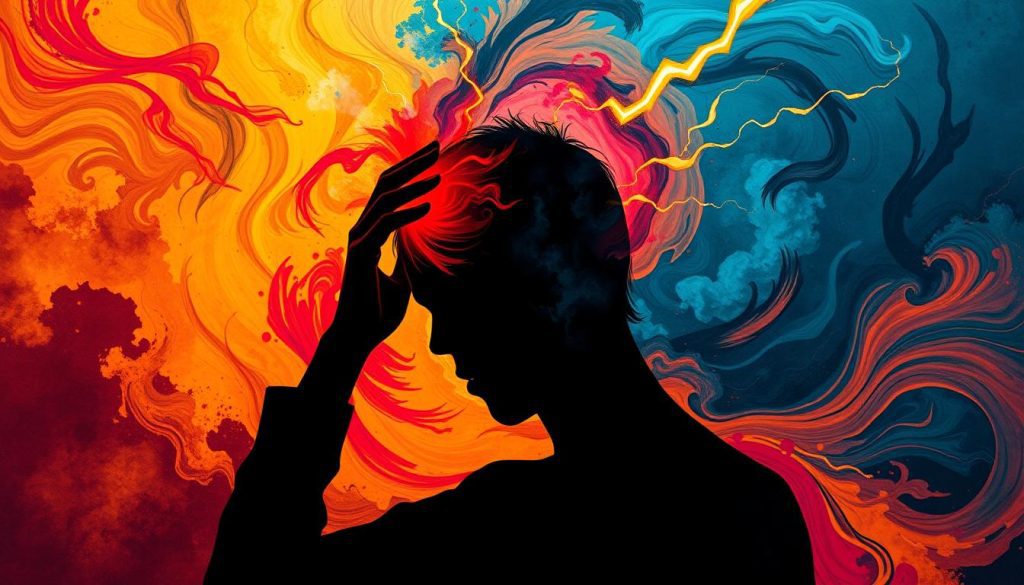
Conclusion
Understanding half head migraines is key to managing them well. Knowing the symptoms and what triggers them helps. This way, people can work with their doctors to find the best treatment.
Managing migraines means using many approaches. This includes medical treatments and changes in lifestyle. By looking at what affects them and trying new therapies, people can fight their half head migraine better.
It’s possible to find relief and prevent migraines. But, it takes working with doctors and making changes every day. By being careful and using the right treatments, people can control their migraines. They can feel better and live a fuller life.
FAQ
What is a half head migraine?
A half head migraine, or unilateral migraine, affects one side of the head. It’s known for severe, throbbing pain on one side of the head.
How do half head migraines differ from other types of headaches?
Half head migraines are different from other headaches like cluster and tension headaches. They are unique because they only affect one side of the head. They also come with symptoms like nausea, sensitivity to light and sound, and visual disturbances.
What are the common symptoms of a half head migraine?
The main symptoms of a half head migraine include severe pain on one side of the head. You might also feel sensitive to light and sound, nauseous, and experience visual disturbances like aura or blind spots. Some people may feel mood changes or cravings before a migraine starts.
What can trigger a half head migraine episode?
Many things can trigger a half head migraine. Environmental factors like bright lights and loud noises can cause them. So can certain foods, hormonal changes, stress, lack of sleep, and physical exertion.
How are half head migraines diagnosed?
To diagnose a half head migraine, doctors do a thorough medical check. This includes a detailed medical history, physical exam, and sometimes imaging tests. They use specific criteria to confirm the diagnosis and rule out other headaches.
What are the treatment options for half head migraines?
Treatment for half head migraines includes immediate relief, preventive meds, and lifestyle changes. Immediate relief might be over-the-counter pain relievers, cold or hot compresses, and relaxation techniques. Preventive meds like anti-seizure drugs or Botox can help reduce migraine attacks. Lifestyle changes like managing stress, improving sleep, and adjusting your diet are also important.
When should someone seek emergency care for a half head migraine?
If you have a sudden, severe headache with symptoms like slurred speech, vision changes, numbness, or a high fever, seek emergency care. These could be signs of a serious condition that needs immediate medical attention.